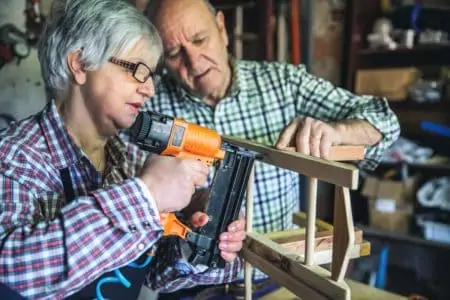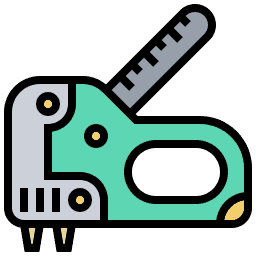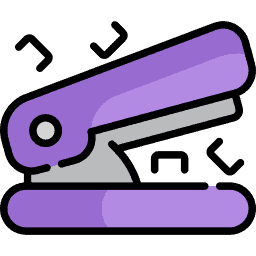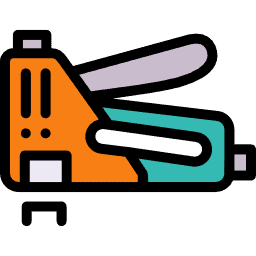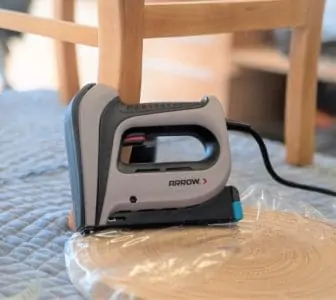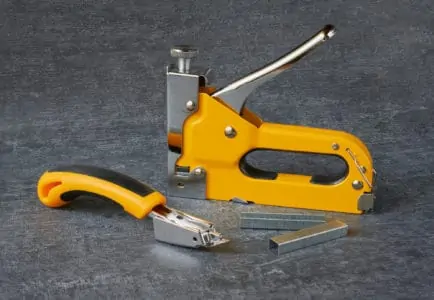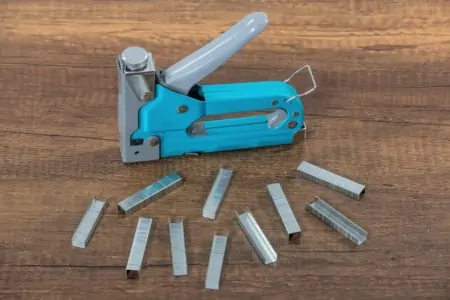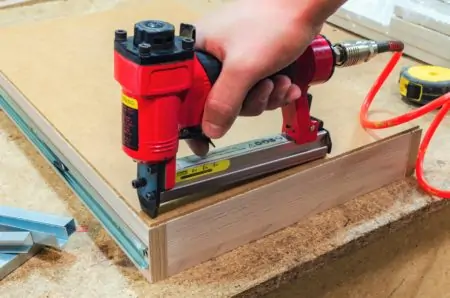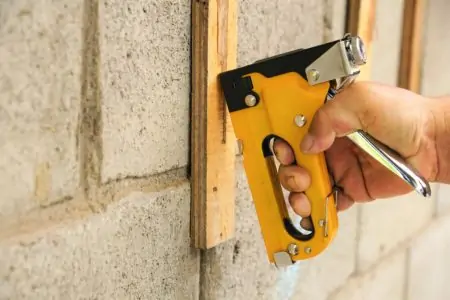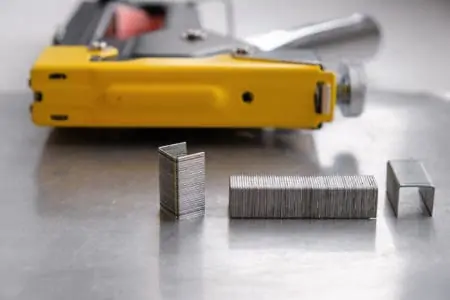Staple guns are essential tools that speed up your work rate to help you get the job done. However, getting the project completed is only part of the story, with the other half being about safety.
Knowing how to use a staple gun improves your efficiency and the quality of your work. So, what are the best techniques? Let’s find out.
Key Takeaways
- Know your staple gun type: manual, electric, or pneumatic, and learn how to load and use each one safely.
- Always wear appropriate safety equipment, such as goggles, gloves, and ear defenders for pneumatic guns.
- Practice on scrap material to improve your technique and get a feel for how the staple gun handles.
- Follow safe practices, such as transporting the gun safely, unloading it when not in use, and using the correct staples for your project.
What You Need
As with all DIY tasks, personal safety should be at the forefront of your mind. Think of the staple gun as a dangerous tool and get the right PPE. So what do you need?
- Goggles.
- Ear defenders.
- Gloves.
- New fasteners.
- Staple remover.
How To Use a Staple Gun
The techniques vary depending on the type of staple gun you own. Essentially, there are 3 staple guns on offer.
Loading and Using a Manual Staple Gun
Loading a manual staple gun is straightforward enough. Locate the 2 indentations at the rear of the shaft. Press them in using your thumb and forefinger. Release the clip on the end of the magazine chamber, push the rod in, and then withdraw it.
Remove the push rod entirely, revealing the empty magazine chamber. Load the staples into the channel, making sure the crown faces upwards and the legs slot into the grooves on either side.
Push the line of fasteners until they reach the end where the firing mechanism is located. Grab the push rod and insert it into the chamber. Now secure the clip at the rear to hold it in place.
Put on your goggles and gloves to protect you from ricochets. Make sure the safety clip is off, releasing the handle. Grab it firmly in your dominant hand, gripping the stapler with your palm resting on the handle.
Touch the nozzle of the staple gun onto the surface of your project and press down, using steady pressure.
The staple will fire, and you might experience a little kickback. After the first couple of attempts, you will get a feel for how the gun reacts, and you will improve your technique. You can also adjust the pressure applied to the fastener by twisting the knob on the top of the gun.
Loading and Using an Electric Staple Gun
Make sure you unplug electric staple guns before loading. Locate the 2 indentations at the rear of the gun and depress them using your thumb and forefinger. As the magazine releases, pull it out.
Insert the new strip of fasteners, making sure the legs face downwards. Hold them in place with your hand while you clip in the magazine to lock them in place.
Put on your safety equipment first, and then plug the stapler into the power supply. Hold the base of the staple gun flat against your project surface, making sure you hold the gun using steady pressure.
Use your free hand to press down on the gun to reduce instances of recoil. If you have a trigger nose, push down, and the fastener releases automatically, but if you have a trigger-activated model, pull the trigger, and the staple fires.
If you have a pressure knob, you can adjust it to accommodate for different materials and tasks. For example, laying electrical cables requires that the fastener only pushes halfway in, so getting the pressure set right is crucial.
Loading and Using a Pneumatic Staple Gun
Loading a pneumatic staple gun involves disconnecting the hose from the air compressor. Next, push the lever at the front of the gun to release the follower and slide it out until it snaps into position.
You should now have an empty chamber. Grab a strip of fasteners and insert them into the channel with the legs facing down and touching either side of the wall. Push the strip along until it reaches the end of the chamber.
Release the lever that allows the follower to slide back into position. Make sure it snaps in place to secure the staples. It should do this automatically, but if it doesn’t, give it a gentle tap.
Connect the tool to the air hose and switch on the compressor. Put on your safety gear, making sure you use your ear defenders because air compressors are noisy. The technique is the same as using an electric gun.
Place the nozzle against the flat surface, and with your free hand, press down to suppress any recoils. Squeeze the trigger, and the air rushes through the air hose from the compressor, powering the tool to drive the staple into the material.
Many pneumatic staple guns have an adjustable trigger that allows you to adapt the speed that the fastener fires, making it easier to carry out different applications.
Tips for Using a Staple Gun Safely
There are safe practices when handling and using a staple gun, so let’s see some of those top tips to keep injuries at bay.
Transport It Safely
When you carry the staple gun to the project, always make sure the gun faces downward and away from the body. Keep your finger away from the trigger and engage the safety lock if you have one.
Keep the Gun Unloaded
When you store the gun, take out the fasteners. It prevents the gun from causing injury should it fall into the wrong hands.
Careful Where You Point It
Don’t point your staple gun at anyone or yourself. Misfires do happen, and a staple gun can do a lot of damage.
Get To Know Your Staples
Load your staple gun with the correct staples for the application. Firing the wrong fastener could cause ricochets and increase the chances of recoil.
Practice Makes Perfect
Grab a scrap piece of wood and practice firing staples. You learn how well the stapler handles and you can improve your technique before moving onto your actual project.
FAQs
Have Fun With a Staple Gun
Learning how to use a staple gun safely is paramount if you want to avoid a trip to the emergency room, so getting to know the best techniques could be a life-saver.
Staple guns are immensely useful. They speed the fastening process, increasing your versatility and productivity. If you are working on an upholstery task, attaching trim inside and outside, or insulating the roof space, a staple gun is the best tool.
